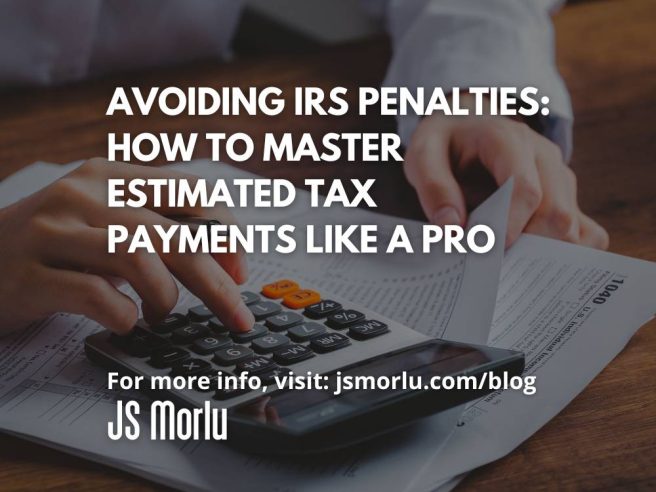Estimated tax payments can feel like that confusing mini-boss in the game of financial planning—easy to ignore, but costly if you do. For business owners, high-net-worth individuals, and anyone with non-W2 income, mastering the art of quarterly tax payments is crucial. If you’ve ever been surprised by an IRS penalty for underpayment, you’re not alone—and this guide is here to help you avoid that pitfall.
Let’s break down what you really need to know about safe harbors, payment timing, and smart strategies that could save you thousands.
The Hidden Sting: What Is the IRS Underpayment Penalty?
Think of the IRS underpayment penalty like interest on a loan—but instead of borrowing money, you just didn’t pay enough tax throughout the year. The IRS expects you to “pay as you go,” not in one lump sum at tax time. So if you fall short, they’ll charge you interest—sometimes a hefty amount.
This catches many taxpayers off guard, especially those whose income fluctuates, like consultants, freelancers, or folks who cash in stock options or real estate late in the year.
Safe Harbors: Your Legal Shield Against Penalties
Here’s the good news: The IRS offers “safe harbors” to help you avoid penalties, even if your actual tax liability turns out to be higher.
The General Rules:
- Pay 90% of your current year’s total tax bill, or
- Pay 100% of last year’s tax liability (or 110% if your adjusted gross income exceeded $150,000)
If you meet one of these, you’re generally safe—even if you owe more in April. But there’s a catch…
Timing Is Everything: Ratable Payments Explained
The IRS doesn’t just care how much you pay—they care when you pay it.
Estimated payments are due four times a year: April 15, June 15, September 15, and January 15 of the following year. If your income is stable, it’s easy to divide your total into four chunks. But if you get a windfall in Q3 or Q4—like a stock sale or year-end bonus—you might be underpaid for earlier quarters, triggering penalties.
This is where most people run into trouble.
The IRS’s Quarterly Trap: Why Uneven Income Creates Risk
The IRS calculates underpayment penalties quarter by quarter. If you underpaid in Q1 but overpaid in Q4, they won’t average it out. You’ll still owe penalties for Q1.
So, if your income varies, you need a better strategy than just guessing.
Power Move: Use IRS Form 2210 to Save the Day
Enter IRS Form 2210, your secret weapon.
This form lets you annualize your income, showing the IRS that your earnings weren’t evenly distributed. By proving that your income was low in earlier quarters, you can often reduce or eliminate penalties. It’s a game-changer for seasonal businesses, real estate investors, and anyone with income spikes.
Two Brilliant Workarounds to Reduce IRS Penalties
When you realize you might be underpaid, you still have options—especially if it’s late in the year.
1. Increase Withholding
W-2 withholding is treated by the IRS as if it were paid evenly throughout the year, even if it’s all done in December. That means:
- You can adjust your W-4 at work to withhold more for the rest of the year.
- If you’re married and your spouse has W-2 income, bump up their withholding too.
- Selling a big asset? You can increase withholding through payroll instead of making a quarterly payment.
This trick can backfill earlier missed payments—like a time machine for tax compliance.
2. Strategic Retirement Distributions
Here’s a savvy move for taxpayers over 73 (or anyone taking a distribution from a retirement plan):
- Take a large taxable distribution with 20% federal withholding.
- Roll the full amount back into the plan within 60 days using different funds.
- Keep the withholding—it’s now a payment to the IRS!
This technique helps you “create” a large tax payment that’s treated as evenly spread throughout the year.
Note: Be careful with this—IRS only allows one rollover per 12 months. Also, some institutions restrict how much you can withhold from RMDs.
Real-World Example: Bob the Lamp Mogul
Let’s say Bob owns a thriving designer lamp business. Business is seasonal, and 70% of his profits come in Q4. If Bob pays equal quarterly estimates, he’ll be short in Q1–Q3 and potentially owe penalties—despite paying more than 90% of his total tax by year-end.
Using Form 2210 to annualize income, Bob shows the IRS that his earnings were minimal in Q1–Q3. He avoids penalties and keeps his cash flow intact when he needs it most.
Final Take: Don’t Wait—Plan Ahead
The earlier you address estimated tax planning, the more options you have. Waiting until December limits your ability to fix underpayments and may leave you stuck with a penalty bill you could have avoided.
At JS Morlu, we help high-net-worth individuals, small business owners, and consultants stay ahead of IRS surprises. From tax planning to real-time income tracking, our proactive approach keeps your financial strategy on point.
👉 Need help assessing your estimated payments before year-end?
Schedule a tax planning consultation today. The clock is ticking—and your money deserves a smarter strategy.
JS Morlu LLC is a top-tier accounting firm based in Woodbridge, Virginia, with a team of highly experienced and qualified CPAs and business advisors. We are dedicated to providing comprehensive accounting, tax, and business advisory services to clients throughout the Washington, D.C. Metro Area and the surrounding regions. With over a decade of experience, we have cultivated a deep understanding of our clients’ needs and aspirations. We recognize that our clients seek more than just value-added accounting services; they seek a trusted partner who can guide them towards achieving their business goals and personal financial well-being.
Talk to us || What our clients says about us

